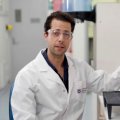A physicist from The University of Queensland (UQ) has helped make a breakthrough discovery that will turn quantum computers from a theory into a reality.
The discovery means that super-fast computers can now be built that are far more powerful than current computers, allow complex computations that are not currently possible and able to devise un-breakable codes.
Scientists around the world have been trying for the past 20 years to build a quantum computer with component parts made up of just single atoms and electrons. However, no one has built a quantum computer with more than a handful of quantum bits.
One of the major problems is that it is difficult to build a computer on a sub-atomic scale without any faults, missing components or broken connections.
Dr Tom Stace, from UQ’s School of Mathematics and Physics, has been studying what impact these errors would have on the operation of quantum computers and, together with international colleagues, has found that quantum computers can still work even with a large number of faulty or missing components and connections.
“We have shown that quantum computers can tolerate a surprisingly large rate of errors, as well as losing up to 25 percent of their basic components, called quantum bits, or qubits,” Dr Stace said.
Dr Stace’s research into the fault tolerance of quantum computers, published this week in Physical Review Letters, was a collaboration with Sean Barrett, from Imperial College London and builds on results the pair published in 2009.
Another paper by Stace and Barrett, together with researchers at Oxford and the National University of Singapore, soon to appear in Physical Review Letters, shows that quantum computers can also tolerate very high levels of faults in establishing connections between qubits.
“We have also found that a high failure rate of connections between components is tolerable, with the quantum computer still able to operate with up to 90 percent of failed connections.”
Dr Stace says the findings provide targets for experimental efforts, and will allow people to now start building larger scale quantum computers.
Copies of the two published papers can be viewed at http://link.aps.org/doi/10.1103/PhysRevLett.105.200502 and http://link.aps.org/doi/10.1103/PhysRevLett.102.200501
Media: Dr Tom Stace (stace@uq.edu.au, 0404 413 069) or Kathy Grube, UQ Communications, (k.grube@uq.edu.au, 07 3346 0561)
.jpg)











